Mumbai belies concrete tag to feature as core habitat of dragon and damselflies in first-ever GIS-tagged Atlas of Odonata of the Western Ghats of India

Fulvous forest skimmer, neurothemis fulvia (Drury) breeds in marshes near forest streams and rivers
Having flown around the Earth for 300 million years, dragonflies remind us to take time to reconnect with our strength, courage and happiness. The popular anonymous quote couldn't have been truer in the context of Mumbai, which features prominently in the first-ever study of 193 known dragonfly and damselfly species found in the Western Ghats, of the total 488 that exist in India, and 6,256 all over the globe.The Atlas of Odonata (Insecta) of the Western Ghats ('2,180), published by the Zoological Survey of India (ZSI), is a colourful compendium, which uses GIS tools to reiterate the need to conserve the 74 species that are endemic to the Ghats, and Mumbai's freshwater bodies that form crucial hubs for their growth.
The research took 10 years and involved five fauna experts, who captured the dragonflies on hi-resolution macro and micro lens; leading to a detailed Odonata map of the distinct sections of the 1600 km long mountain range along the west coast of India. The findings reiterate the need for conserving the acutely threatened wetlands, including ponds, lakes, marshes and reservoirs, where the aquatic agile flier insects thrive and procreate.
ADVERTISEMENT
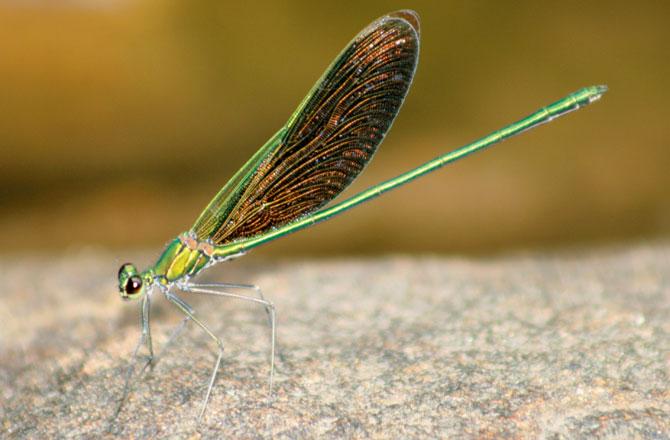
Streamglory, Neurobasis chinensis (Linnaeus) mainly breeds in hill streams
The Altas of Odonata is of particular interest to conservationists, biologists, ecologists and other natural history scholars, who now have confirmed geospatial evidence of the presence of dragonflies and damselflies. Photographic field guides and small-scope Odonate fauna studies have been done in India in the past. But this is the first time that ZSI has focused on the Western Ghats, which has been earmarked by Conservation International as one of 34 global biodiversity hotspots.
Since graphics and mapping help local researchers identify species distribution, it encourages further work on specific biology and ecology, so as to add information to the current atlas, observes Dr K A Subramanian, head ZSI scientist and author in the five-member team. He is part of the Dragonfly Specialist Group, a global network of 50 scientists and conservationists from 28 countries, working towards a much-awaited global dragonfly assessment.
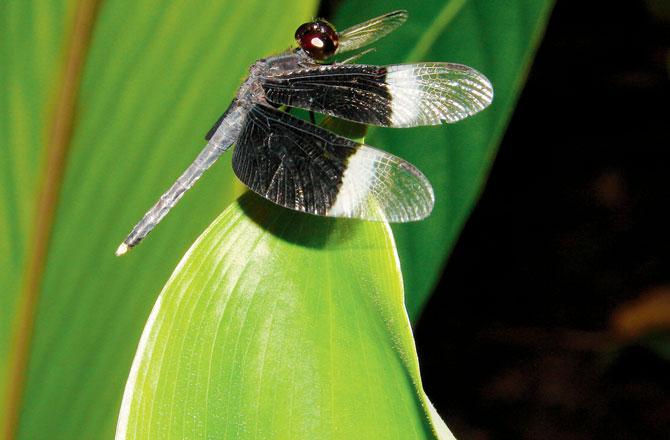
Pied paddy skimmer, Neurothemis tullia (drury) found common around irrigation canals and paddy fields throughout the Western Ghats
The other makers of the atlas, Dr KG Emiliyamma, Dr R Babu, Dr C Radhakrishnan and Dr SS Talmale lent able support, with Talmale specifically focusing on Maharashtra. He has studied the fauna at Borivali's Sanjay Gandhi National Park, as well as the Bhimashankar Wildlife Sanctuary near Pune. Dr Talmale reiterates that no fauna study is final and ZSI wants younger habitat researchers to continue micro-monitoring and contributing individual results to the larger database. For instance, the Tansa lake catchment area and the adjoining sanctuary can pave the way for taxonomic research of dragonflies, which can be aided by the Atlas of Odonata. In a bid to make the atlas freely accessible, it will soon be uploaded on the ZSI website.
Incidentally, the ZSI has to its credit 1,600 publications. Among these, the latest atlas is a proud Indian's read, taking us on a picturesque journey through six Indian states, extending from the south of the Tapti River (near the Gujarat-Maharashtra border) up to Kanyakumari, the southernmost tip of the Indian peninsula. Through the prism of dragonflies and damselflies, the reader navigates a unique climate mix — the lower parts of the ghats have a humid and tropical environment, whereas the elevated regions have a more temperate climate; the western side is on the threshold of the southwest monsoon, while the eastern side lies in the rain shadow area.
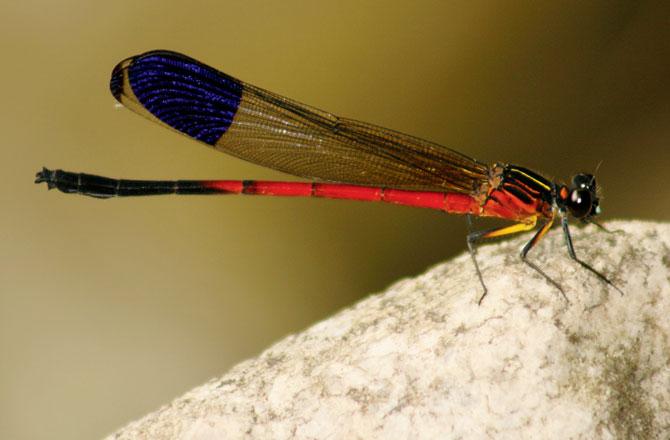
Nilgiri Torrent Dart, Euphaea dispar Rambur, endemic to Western Ghats, found in evergreen forests of Karnataka,Kerala and Tamil Nadu
The distribution of Odonota species also has interesting patterns. High diversity and endemism is reported from the hills like Nilgiri-Wayanad-Kodagu complex and Anaimalai. The upper catchments of rivers Cauvery, Chaliyar, Bharatapuzha and Periyar report nearly 130 species; while the endemism drastically drops in southern landscapes. This could also be due to inadequate surveys, especially in Tamil Nadu. It is observed that forested hill streams and rivers have higher dragonfly diversity than agriculture-dominated landscapes of downstream plains.
Each odonata photographed for the book evokes child-like wonder from the reader. The cover makes space for a photograph of the Macrogomphus annulatus (Keiser's forktail) which is native to India, mostly Maharashtra; the rare damselfly Calocypha Laidlawi breeds in forest streams and rivers flowing through Karnataka's myristica swamps; Copera Vittata common in rainwater puddles and swamps; Aethriamanta brevipennis is found in lands as diverse as Arunchal Pradesh, Kerala and Maharashtra, including Laos, Myanmar and Thailand! The atlas raises the dragonfly, a minor insect, to the status of a species that has a noteworthy link in the wetland food chain. For those guilty of the childhood pastime of tying a ribbon to the dragonfly's wings, the atlas proves to be an eye opener.
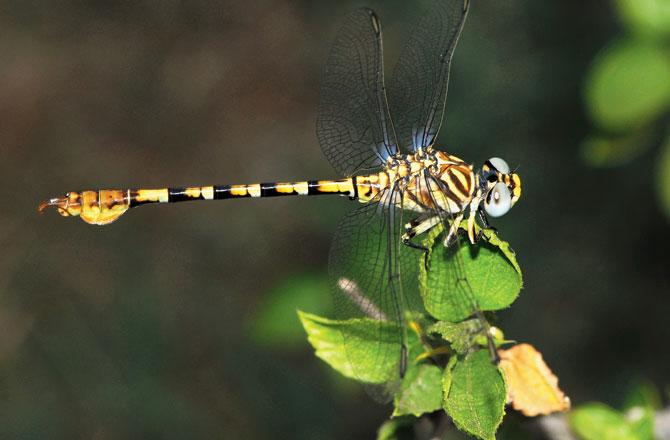
Common Hook-Tail, Paragomphus lineatus (Selys) commonly found near streams, rivers, ponds and lakes
Recent studies have revealed that species assemblages of dragonflies can change with levels of human disturbance. Dragonflies found at undisturbed habitats with good riparian vegetation, were specialists. But species recorded in industrial land or urban areas with disturbed riparian vegetation were generalists with wide habitat preference and distribution.
These studies also show that dragonflies are sensitive not only to the quality of the wetland they breed and live in but also to major landscape changes. Studies conducted in Eastern Himalayas and Peninsular India demonstrate that Odonate fauna of the subcontinent is threatened due to anthropogenic activities such as habitat destruction, agricultural expansion, pesticides and industrial pollution.

Dr KA Subramanian, member of the Odonata Specialist Group
Late adman and nature poet Nalesh Patil's upcoming collection of environment poems has a beautiful Odonata reference: Chatur pankhavarti uoon vajvat phirti/As the dragonfly soars in its flight, its wings drum up sunlight! Dragonflies are called chatur in Marathi, a word that translates to 'intelligent.' The atlas reminds us that colourful dragonflies, customarily underrated in folklore and literature when compared to butterflies, moths and bees, are a sign of a healthy ecosystem. If not for any other reason, because of the crucial function they play as aerial predators. Maintaining and protecting open spaces means that we will allow dragonflies to do their job of keeping mosquitoes, black flies and other blood-sucking bugs, which they feed on, in check. And what better time to appreciate this fact than during the monsoon?
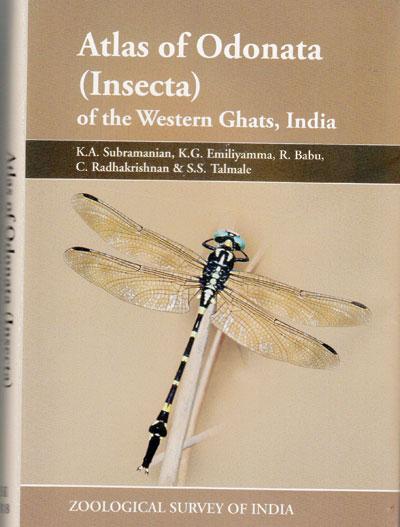
Deccan Bowtail, Macrogomphus annulatus (Selys) found in Pune and Thane district of Maharashtra, which usually perch on riparian vegetation along stream sandrivers
74
Number of species endemic to the ghats, of which Mumbai's water bodies form a part
193
Known dragonfly, damselfly species surveyed in this Atlas' research
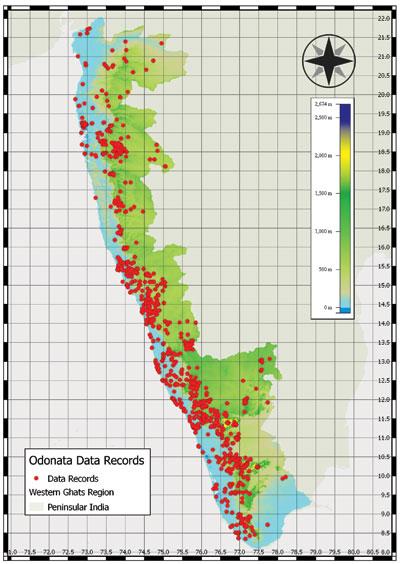
Map of Western Ghats showing Odonata location data points used in the present study
A short lesson
Odonates have an elaborate scientific nomenclature befitting their elongated transparent winged bodies, capable of transoceanic migration, dominant territorial defense mechanism and an in-flight choreographed mating process.
Sumedha Raikar-Mhatre is a culture columnist in search of the sub-text. You can reach her on sumedha.raikar@gmail.com
Catch up on all the latest Crime, National, International and Hatke news here. Also download the new mid-day Android and iOS apps to get latest updates
 Subscribe today by clicking the link and stay updated with the latest news!" Click here!
Subscribe today by clicking the link and stay updated with the latest news!" Click here!







